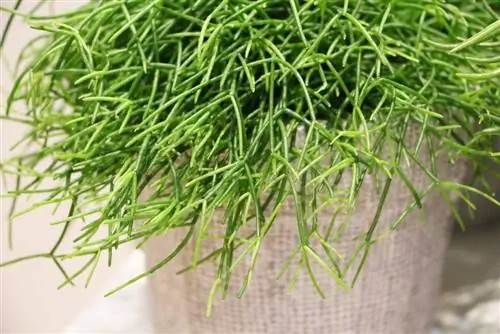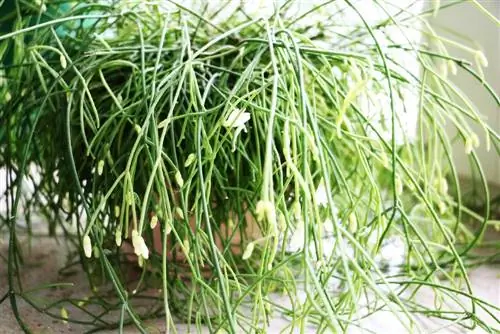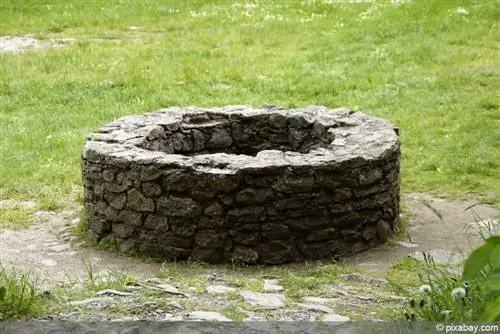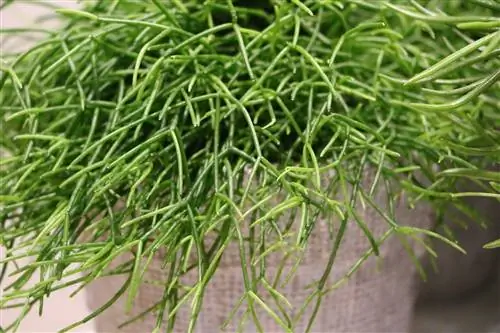- Author admin [email protected].
- Public 2023-12-17 03:39.
- Last modified 2025-01-24 12:45.
Rhipsalis pilocarpa has cylindrical, well-branched branches. These have a diameter of around 6 millimeters and are covered with areoles, i.e. hair cushions with white hairs. This is also a good way to recognize the cactus. The shoots initially grow upright, can be up to one meter long and hang downwards as they grow longer. The limbs are round. The individual ribs are finely striped longitudinally and transversely. The color of the flowers is white. They are terminal and fragrant. The flowers appear singly or in pairs and reach a diameter of up to 4 centimeters. The green, somewhat woolly areoles are occasionally tinged with purple.
Location
Rhipsalis pilocarpa needs a bright and warm location. Avoid direct sunlight as strong sunlight can cause burns. Otherwise, the plant can be cultivated indoors all year round. However, it likes it when you take it outdoors in summer, but here too it is protected from the midday sun, too much rain and strong wind, which can tear off the shoots.
Planting substrate
Very permeable soil is suitable as a plant substrate. Cactus soil contains a lot of peat. This always keeps the moisture for a long time, which is not so cheap. The plant's small roots often rot away. A mixture of lava, tuff and pumice is better. You can also use normal soil and mix it with sand. It can also contain humus, but it's better not to use peat.
Pouring
Rhipsalis pilocarpa does not need excessive watering. Like all cacti, the plant is very undemanding. Watering once a week is usually sufficient. It is rarely dramatic if you forget to water every now and then, although it is better not to allow the plant ball to dry out completely. If it is very dry, it can be dipped in water so that it can soak up properly again. It is important to remove excess water from the saucers and planters after watering. You wait about 10 to 20 minutes after giving water and check whether any standing water needs to be poured out. Frequently wet feet quickly lead to root rot, from which the plants rarely recover. So it's better to forget to water than to add too much water. In summer, when it is very hot, you should water a little more often.
Fertilizing & Overwintering
Rhipsalis pilocarpa is fertilized between February and July, preferably with a diluted superphosphate solution or normal cactus fertilizer.

Rhipsalis pilocarpa overwinteres warmly, but cooler than in summer. Temperatures between 10 and 15 °C are ideal. This means the plant produces flowers well. Little is watered in winter. The cooler the cactus is or hangs, the less it needs to be watered. If you overwinter at just 5 ËšC, stop watering completely.
Cutting & Propagation
A cut is usually not necessary. If you want the plant to be denser, you can trim it carefully from time to time. Unsightly shoots can simply be cut away.
Rhipsalis pilocarpa is propagated by cuttings. To do this, cut cuttings about 10 centimeters long from the mother plant. These are left to dry for about 10 days in a sunny and not too warm place. The cuttings are then potted, ideally in groups. The planting depth is about a third of the cuttings. A soil-sand mixture, such as commercially available cactus soil, is suitable as a planting substrate. The location for the cuttings should be light to partially shaded. Direct sun should be avoided! Temperatures around 20 °C are beneficial, as is high humidity. It is therefore advisable to put a bag over the growing container. However, you have to ventilate daily to prevent the soil from forming mold. The soil must always be kept slightly moist, never wet. As soon as new cactus members appear, you can accustom the young plant to the room climate.
Pests and diseases
Mealybugs are more common pests. These can be combated with neem or paraffin oil products.
If you water too much and the plant ball is often in water, root rot will quickly occur, which will result in the cactus dying.






